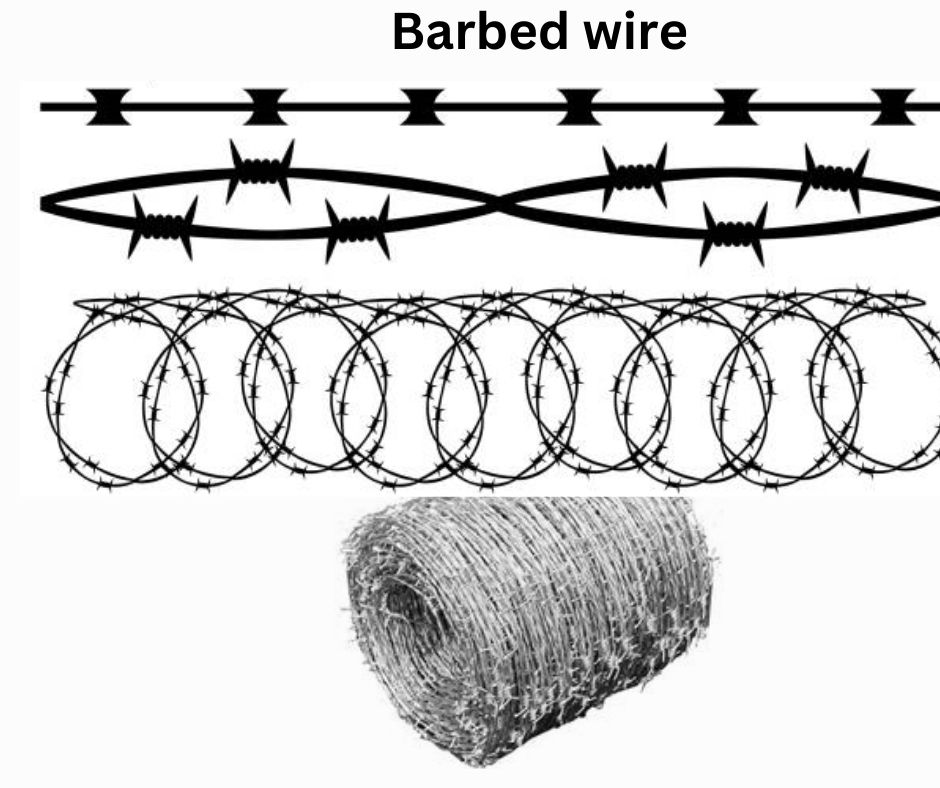Barbed Wire: Applications and Significance in Various Industries
Barbed wire is a versatile fencing material that has been used for decades in various industries for its effectiveness in providing security and control. Composed of twisted strands of wire with sharp barbs evenly spaced along its length, barbed wire serves a multitude of purposes, ranging from agricultural and livestock management to security applications. This article explores the diverse applications and significance of barbed wire in different industries.

- Agricultural Sector:
In the agricultural sector, barbed wire plays a crucial role in protecting crops and livestock. It serves as a cost-effective fencing solution to prevent the intrusion of wild animals and stray livestock, minimizing the risk of damage to valuable crops and ensuring the safety and containment of animals. Barbed wire fences are also employed to mark property boundaries and segregate different sections of land, facilitating efficient land management practices.
- Livestock Management:
Barbed wire fences are widely used to enclose pastures and establish boundaries for livestock. The sharp barbs act as a deterrent, discouraging livestock from attempting to breach the fence and wander off. This not only prevents animals from straying onto neighboring properties but also minimizes the risk of accidents on roads and highways. By providing secure enclosures, barbed wire fences aid in effective livestock management and contribute to the overall safety of animals and surrounding areas.
- Security and Perimeter Protection:
Barbed wire is extensively utilized in security applications to enhance perimeter protection. Its sharp barbs create a formidable barrier, acting as a visual and physical deterrent against unauthorized entry. Barbed wire fences are commonly employed in military installations, correctional facilities, and high-security areas to fortify boundaries and prevent trespassing. The mere presence of barbed wire can serve as a psychological deterrent, dissuading potential intruders from attempting unauthorized access.
- Construction Sites and Industrial Areas:
Construction sites and industrial areas often require temporary security measures to safeguard valuable equipment, materials, and property. Barbed wire fences offer a quick and efficient solution for such scenarios. They provide a clear boundary, preventing unauthorized access and deterring theft or vandalism. Barbed wire can be easily installed and removed, making it suitable for temporary security needs during construction projects or at industrial sites where additional protection is required.
- Border Control and Wildlife Conservation:
Barbed wire fences are frequently utilized in border control to demarcate international boundaries and control the movement of people and wildlife. They serve as a physical barrier, aiding border security efforts and preventing illegal crossings. Moreover, barbed wire fences are used in wildlife conservation areas to establish protected zones, ensuring the preservation of endangered species and preventing human-wildlife conflicts.
Size, thickness, length, and weight of barbed wire can vary depending on the specific requirements and standards of different regions and applications. However, I can provide you with some general information regarding these parameters.
Size: Barbed wire typically comes in various sizes, commonly classified as gauges. The gauge refers to the thickness of the wire used in the manufacturing process. Common gauge sizes for barbed wire range from 12 gauge to 15 gauge, with lower gauge numbers representing thicker wires.
Thickness: The thickness of the wire used in barbed wire is an important factor in determining its strength and durability. Thicker wires generally offer more resistance and robustness. Typical barbed wire thicknesses range from 1.6mm (0.063 inches) to 2.5mm (0.098 inches), but again, these measurements can vary depending on the specific product and manufacturer.
Length: Barbed wire is typically sold in rolls or coils. The length of a roll can vary depending on the manufacturer and purpose. Common lengths for barbed wire rolls are 1320 feet (400 meters), 1650 feet (500 meters), or even longer.
Weight: The weight of a roll of barbed wire depends on its length and the gauge and thickness of the wire. As a general guideline, a 1320 feet (400 meters) roll of barbed wire can weigh around 45 to 60 pounds (20 to 27 kilograms), but this can vary.
It’s important to note that these specifications are general guidelines, and specific products may have different dimensions and weights. When purchasing barbed wire, it’s recommended to consult with manufacturers or suppliers to ensure you get the exact specifications that meet your requirements.
The price idea of barbed wire can vary depending on several factors such as the gauge, thickness, length, quality, and the region or country where it is purchased. Additionally, market conditions and fluctuations in the cost of raw materials can also influence the price.
As a result of these variables, it is difficult to provide an exact price without specific details. However, as a general estimate, the cost of barbed wire can range from $0.10 to $0.40 per linear foot, or $1.50 to $4.00 per linear meter.
It’s important to note that this is a rough estimate and prices may vary significantly based on the factors mentioned earlier. To get accurate pricing information, it is recommended to contact local suppliers, manufacturers, or distributors who can provide you with specific quotes based on your requirements.
Barbed wire continues to be a widely employed fencing material across various industries due to its affordability, effectiveness, and versatility. Its applications range from agricultural and livestock management to security, construction, border control, and wildlife conservation. Barbed wire provides an essential tool for maintaining security, managing livestock, protecting valuable assets, and establishing boundaries. As industries evolve, barbed wire remains a reliable and trusted solution for numerous applications, contributing to the safety, efficiency, and integrity of various sectors.
Comments are closed.